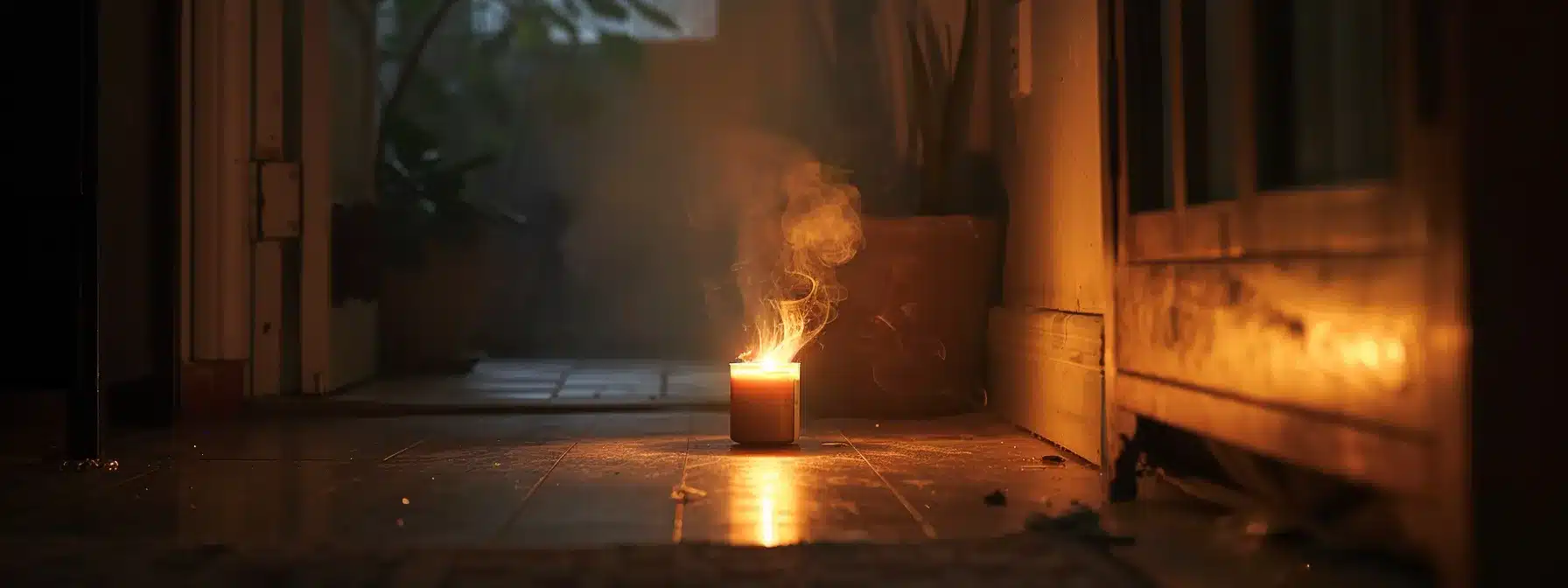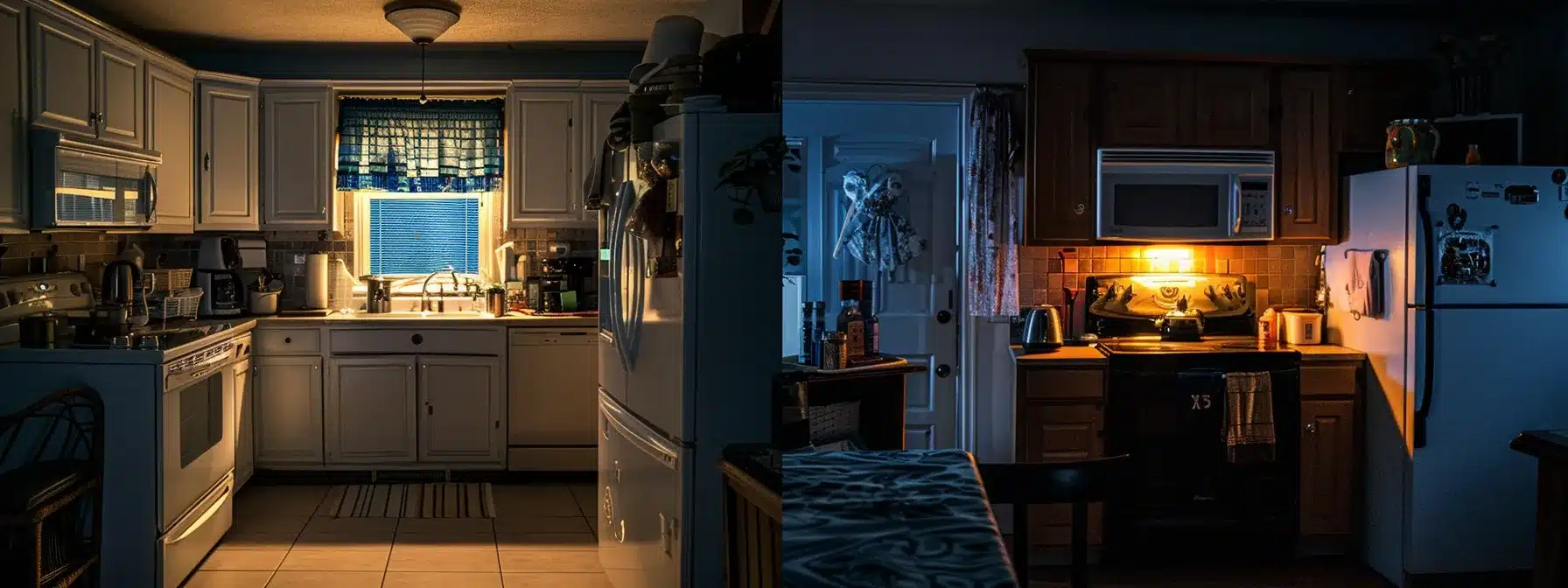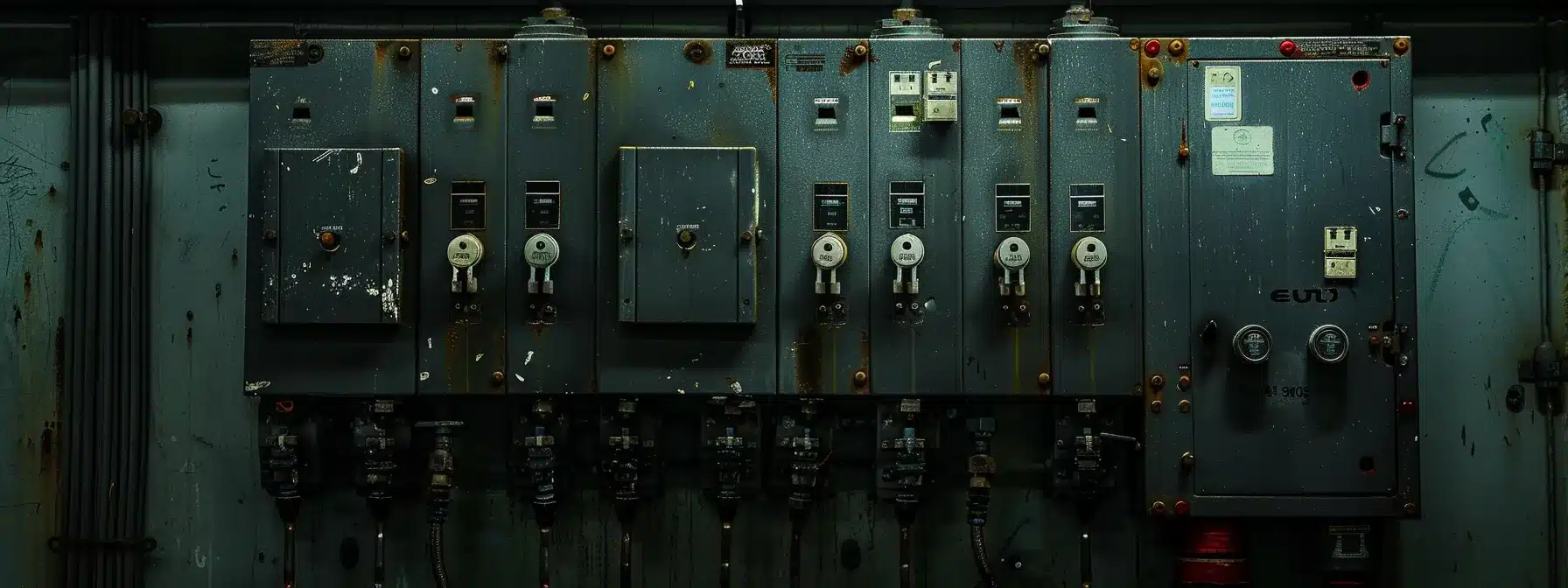When it comes to understanding your home’s electrical system, knowing the signs of an overloaded circuit breaker is essential. Imagine overloading a circuit while using your toaster, charging station, and perhaps even a ceiling sensor all at once. Such situations can lead to serious problems, and having an emergency electrician on speed dial might just save the day. Curious about how to keep your circuits safe and efficient? In this article, you’ll uncover practical tips and insights that can help you avoid electrical overloads and maintain a smooth-running home. Keep reading to learn more!
Key Takeaways
- Flickering lights and frequent breaker trips signal potential circuit overloads
- A burning smell from outlets indicates overheating and requires immediate professional attention
- Distributing high-wattage appliances across circuits helps prevent overloads and enhances safety
- Regular checks for damaged wiring can prevent serious electrical hazards and costly repairs
- Upgrading outdated electrical systems can improve safety and accommodate modern device demands
What Are the Signs of an Overloaded Circuit?

Homeowners and businesses should stay alert to the warning signs of an overloaded circuit, as they can indicate larger issues. Flickering or dimming lights often point to a circuit struggling with too much wattage, making this the first red flag to notice. Frequent trips of the circuit breaker signal that the system is overloaded and needs attention. A burning smell coming from outlets or switches is never a good sign; it’s a clear hazard that should be addressed immediately. Unusual buzzing sounds from the electrical panel can indicate trouble brewing as well. If electrical appliances are overheating quickly, that’s a definitive sign the circuit can’t handle the load. Lastly, anyone feeling unexpected electric shocks from appliances must take this seriously and call in a professional emergency electrician. In these situations, a multimeter can be a handy tool for diagnosing the problem, especially if it’s being used alongside power strips that might be taking on more than they can safely handle.
Flickering or Dimming Lights as a Red Flag
Flickering or dimming lights are often the first signs that a circuit is overloaded. When a ceiling fan kicks on or a vacuum is used, homeowners may notice the lights flicker or dim temporarily. This usually happens because the power supply is stretched thin, struggling to handle the increased load, which can indicate it’s time for a closer look.
If a bathroom light dims every time the water heater fires up, that’s a clear signal that the circuit might be working overtime. These fluctuations can create discomfort and worry, especially during a power outage when reliable lighting is crucial. Ignoring this issue may lead to more significant electrical problems down the road.
Frequent Circuit Breaker Trips Signal Trouble
Frequent circuit breaker trips can indicate a serious overload in a home’s electrical system. When the breaker cuts off power repeatedly, it’s a clear sign that there’s too much voltage running through a single circuit. This should never be overlooked, as increased trips can lead to potential safety hazards and costly repairs, making it crucial to consult an electrician for a closer examination.
Understanding why circuits trip often requires knowledge of the electronics in use. Homeowners may find that plugging in multiple high-wattage devices can overload a circuit designed for lighter loads. Regularly tripping breakers not only affects daily activities but also increases stress on the wiring itself, which can cause further issues down the line.
Staying aware of these signs is key to maintaining electrical safety at home or in a business. If a circuit breaker frequently shuts down, it’s best to avoid using multiple electronics simultaneously until a qualified professional evaluates the situation. Ignoring frequent trips often leads to more significant risks and problems requiring urgent attention.
- Frequent trips signal potential overload issues.
- Increased voltage can risk safety and stability.
- Consulting an electrician ensures proper evaluation.
- Understanding load requirements protects the wiring.
- Awareness leads to proactive electrical maintenance.
Burning Smell From Outlets or Switches
A burning smell coming from outlets or switches is a clear indication of potential issues lurking within the electrical system. This unpleasant odor often signifies an overcurrent situation, where appliances or devices are drawing too much power, leading to overheating. Homeowners should never ignore this red flag; it often requires immediate inspection and possibly troubleshooting by a qualified electrician.
Common situations that trigger this smell include using high-wattage devices such as space heaters or overloading circuits with multiple electronics. If the wiring or electrical components are unable to handle the power demands, it creates resistance and can result in a burning aroma. It’s essential to stay vigilant and check connections when this smell arises, as it could signal serious safety concerns.
Regular inspections can help prevent hazardous situations, ensuring that lighting, outlets, and other components function safely. If anyone smells something burning, they should unplug devices immediately and investigate the source. Remember: addressing potential problems early can save homeowners from larger headaches down the road.
- Burning smell often indicates an overcurrent issue.
- High-wattage devices, like space heaters, can lead to overheating.
- Ignoring these signs may result in serious safety risks.
- Regular inspections help keep the electrical system in check.
- Troubleshooting is necessary for ensuring home safety.
Unusual Buzzing Sounds From the Electrical Panel
Unusual buzzing sounds coming from an electrical panel can be a clear sign that something isn’t quite right. This noise might occur when high-wattage devices, such as a hair dryer or a vacuum cleaner, are being used. If these sounds seem out of place, it’s time to take action and seek help from a knowledgeable electrical contractor.
Sometimes, this buzzing can be linked to faulty connections within the panel or overloaded circuits that simply can’t keep up with demand. Homeowners might notice the noise intensifying when multiple devices are in use, particularly during peak usage times. If there’s also an accompanying odor that resembles burnt plastic, that situation definitely calls for immediate professional attention.
Being proactive about these sounds can prevent further complications, including potential fire hazards. Using surge protectors for sensitive electronics can help manage some of the load, but persistent buzzing indicates an underlying problem that should not be ignored. Keeping tabs on electrical equipment and calling an expert can make all the difference in maintaining a safe electrical system.
Electrical Appliances Overheating Quickly
When electrical appliances begin to overheat quickly, it often signals an issue with the circuit that powers them. Wires carrying too much current can generate heat as they work harder than they should, which can damage their insulation. This can create a dangerous situation, increasing the risk of a short circuit or even a fire caused by overheated metal components.
If a fuse blows or a breaker trips frequently, that might hint at an overloaded circuit. This is especially true if appliances are running hot, which suggests that the wiring is struggling to keep up with the demand for power. Homeowners should take this seriously, as continued use of overloaded systems can lead to permanent damage and potential personal injury from electric shocks.
Recognizing the signs of overheating is crucial for preventing injury and ensuring a safe environment. It’s smart for anyone noticing these patterns to call in an experienced electrician to investigate further. Ignoring these warnings can result in injuries and costly repairs, turning a minor inconvenience into a major safety hazard.
The Shocking Reality of Electric Shocks From Appliances
The shocking reality of electric shocks from appliances is a concern many homeowners face. When an electric current flows through a device without proper grounding, it can create dangerous situations. A faulty insulator or worn-out wiring may lead to appliances discharging electricity unexpectedly, putting anyone in close proximity at risk.
Now that you know how to spot an overloaded circuit, it’s time to take action! Let’s explore some practical tips to keep your electrical system running smoothly and avoid those pesky overloads.
How to Prevent an Electrical Circuit Overload?

Taking proactive steps can make a significant difference in preventing electrical circuit overloads. First, understanding the capacity of your electrical circuits is vital; knowing how much each circuit can handle keeps the load within safe limits. Homeowners should evenly distribute their electrical devices across circuits to avoid overburdening any single line, which can lead to outages. It’s also wise to steer clear of daisy-chaining power strips and extension cords, as this can result in a tangled mess of wiring that’s just asking for trouble. In some cases, it might be time to upgrade the home’s entire electrical system, especially if it hasn’t been updated in years. Regularly checking for and repairing damaged wiring is essential, as even the smallest issues can escalate quickly. Being mindful about the use of light switches, energy star rated appliances, and dimmers can also contribute to a safer electrical environment, ensuring light fixtures shine brightly without the risk of overloading the circuit.
Understand the Capacity of Your Electrical Circuit
Understanding the capacity of the electrical circuit is essential for maintaining a safe environment at home or in a business. Every circuit is designed to handle a specific amount of energy, and exceeding this limit can pose a risk of overload. Homeowners need to pay close attention to how many devices they plug into a single circuit, especially during peak usage times, like when air conditioning systems are working hard in the heat of summer.
It’s wise for individuals to check the amp ratings on their circuit breakers to ensure they are aware of the maximum load each one can take. This simple step allows them to manage their energy usage better and avoid overloading any given circuit. When homeowners are not sure of their circuit capacity, consulting an expert can provide valuable insights to navigate potential hazards.
Being proactive about electrical capacity not only helps in avoiding overloads but can also enhance overall efficiency. Knowing which devices draw the most energy enables better distribution across different circuits, reducing risk. This approach can prevent frustrating power outages and keep appliances running smoothly, no matter the season.
Distribute Electrical Devices Evenly Across Circuits
Distributing electrical devices evenly across circuits is a practical way to maintain proper electrical load management. When too many devices are plugged into a single circuit, it increases the risk of short circuits and overloading, leading to potential emergencies. By spreading out the usage, homeowners can ensure that each circuit, including those connected to junction boxes, remains within its safe limits.
Understanding the specific energy demands of appliances helps in effective distribution. For instance, high-wattage devices should be placed on separate circuits rather than overloading one circuit with multiple heavy users. This smart placement can prevent overheating and the risks associated with a short circuit, protecting the home from unexpected hazards.
Regular monitoring of electrical systems can enhance safety. Utilizing thermography can help identify hotspots in the wiring, indicating where adjustments may be necessary. By keeping an eye on how the electrical load is balanced across the circuits, homeowners can proactively address issues before they escalate into serious problems.
Avoid Daisy-Chaining Power Strips and Extension Cords
Avoiding daisy-chaining power strips and extension cords is essential for maintaining a safe electrical environment in homes and businesses. When multiple extension cords are linked together, it can create significant strain on a single circuit, increasing the risk of overload. Homeowners often think this is a quick fix, but it can lead to hazardous situations, including fires and damage to appliances.
Upgrade Your Home’s Electrical System if Necessary
Upgrading a home’s electrical system can make a big difference in safety and efficiency. Older homes might not have the capacity to handle modern electrical demands, so it could be time for homeowners to think about an upgrade. Investing in a new system not only accommodates more devices but also improves overall energy distribution, reducing risks of overload.
When considering upgrades, it’s vital to consult with a licensed electrician. They can assess the current system and recommend appropriate enhancements based on specific needs. From installing new circuit breakers to adding extra outlets, the possibilities can transform how electricity flows in the home.
A well-planned upgrade not only strengthens safety but can also increase the value of a property. Homeowners who prioritize their electrical infrastructure find that their homes can better support a range of modern devices and appliances. Keeping electrical systems up to date is a smart move for maintaining a safe and efficient household:
Regularly Check for and Repair Damaged Wiring
Regularly checking for damaged wiring can save homeowners from bigger headaches in the long run. Electrical systems are only as strong as their weakest link, and frayed or worn wires can easily lead to overloads or short circuits. Keeping an eye on the state of wiring helps ensure that everything runs smoothly and safely.
When inspecting wiring, it’s wise to look for visible signs of wear, such as discoloration, cracks, or exposed conductors. If a homeowner spots these issues, they should not hesitate to call in a qualified electrician for a closer look. The sooner any damage is repaired, the less risk there is for costly repairs or safety hazards later on.
Taking the time to check wiring and address issues promptly leads to a more reliable electrical system. Homeowners can enhance safety and efficiency by staying proactive about their wiring. After all, a little attention can go a long way in maintaining a safe home environment:
- Inspect for visible signs of wear.
- Call a qualified electrician for repairs.
- Promote a reliable electrical system through regular maintenance.
Understanding how to prevent circuit overloads is only half the battle. Let’s explore what actually causes these overloads to happen in the first place!
What Causes Circuit Overload?

Understanding what causes circuit overloads is essential for maintaining a safe electrical system in any home. Many homeowners may not realize that certain power-hungry appliances can pull a hefty amount of energy, especially when used simultaneously. This combined demand can push a circuit beyond its limits, leading to problems. Looking out for warning signs is crucial; things like flickering lights or frequent trips to the breaker box can signal underlying issues. Moreover, faulty wiring can exacerbate the risk of overload, turning what might seem like a minor inconvenience into a serious safety concern. By identifying these factors, homeowners can take proactive steps to keep their electrical systems running smoothly.
Identifying Power-Hungry Appliances in Your Home
Power-hungry appliances are often the hidden culprits behind circuit overloads in many homes. Items like space heaters, air conditioners, and older refrigerators tend to draw a significant amount of electricity. Homeowners should pay attention to how many of these energy-demanding devices they have running at the same time, as it can quickly add up and strain the electrical system.
Another common suspect is laundry equipment, like washers and dryers. These machines usually require a substantial amount of energy, especially during spin cycles or when running heating elements. If a homeowner finds that the circuit breaker regularly trips while using these appliances, it might be a signal to reevaluate their energy usage habits.
Kitchens also house many energy-intensive devices such as microwaves, ovens, and toasters. Mixing more high-wattage appliances in the same circuit can lead to significant power demands. Being mindful of how these appliances are used, especially during peak cooking times, can help avoid overloading circuits and keep the household running smoothly.
The Impact of Simultaneous High-Power Appliance Use
Using multiple high-power appliances at the same time can strain a home’s electrical system. For instance, if a homeowner is running a hair dryer while the washing machine is on, the combined energy demand could push the circuit beyond its limits. This situation can lead to noticeable signs like flickering lights or even trips to the circuit breaker.
The issue doesn’t just stop at flickering lights. Overloading a circuit through simultaneous appliance use can cause overheating in the wiring, increasing the risk of short circuits or even fires. When several energy-hungry devices draw power together, it creates a heightened safety concern that homeowners should be aware of.
Homeowners should keep tabs on how often they use multiple high-wattage appliances simultaneously. It’s easy to get caught up in daily tasks and overlook the load on each circuit, but being mindful can prevent unexpected outages and costly repairs. Taking simple precautions can make a significant difference in the safety and efficiency of a home’s electrical system.
Warning Signs of an Overloaded Circuit
Homeowners should keep an eye out for several signs indicating that their circuit breaker may be overloaded. One common symptom is flickering lights, which happens when too many devices draw power from a single circuit. This trend can escalate quickly and lead to more significant electrical issues down the line.
Another clear indicator is frequent circuit breaker trips. If the breaker keeps shutting off, it suggests that the circuit cannot handle the load it is experiencing. This not only interrupts daily activities but could also pose a potential safety risk that requires immediate attention.
Additionally, homeowners may notice a burning smell or hear unusual buzzing from electrical outlets and appliances. These signs are serious and shouldn’t be ignored, as they often mean the wiring or connections are overheating. Staying alert to these warning signs helps ensure a safer environment at home:
- Flickering or dimming lights can indicate excessive load.
- Frequent breaker trips suggest an overloaded circuit.
- Unpleasant smells or buzzing sounds are serious red flags.
The Role of Faulty Wiring in Circuit Overload
Faulty wiring plays a significant role in causing circuit overloads. When wires become frayed, worn, or damaged, they can’t carry the amount of current needed for appliances, leading to overheating. This situation not only affects the appliances themselves but can also compromise the entire electrical system’s integrity.
Poor connections within the wiring can also contribute to overload conditions. Loose connections create resistance, generating extra heat as electricity struggles to pass through. If left unaddressed, these hotspots can lead to circuit failures and pose serious safety risks, requiring immediate attention from a professional electrician.
Homeowners should recognize that outdated wiring systems can exacerbate the problem. Many older homes may not be equipped to handle today’s high-demand devices, making it crucial for homeowners to assess their electrical systems. Regular checks and updates can prevent unnecessary strain on circuits and ensure a safer living environment.
Circuit overloads can be a real headache, but the good news is that they can be fixed! Get ready to discover some straightforward solutions to keep your electrical system running smoothly.
How to Fix Circuit Overload

Fixing an overloaded circuit starts with some straightforward measures that can make a big difference. First, unplugging some appliances can help ease the strain on the system and provide immediate relief. Next, homeowners can rearrange their appliance locations to better distribute the electrical load, ensuring that no single circuit is overworked. If circuits continue to struggle, it may be time to consider upgrading their capacity, particularly if the current setup is outdated. Plus, replacing old or faulty circuit breakers with more reliable models ensures the system remains safe and efficient. By taking these proactive steps, homeowners can maintain a balanced and functioning electrical system.
The Initial Step: Unplug Some Appliances
When faced with an overloaded circuit, the simplest and quickest solution is to unplug some appliances. This immediate action reduces the strain on the electrical system, providing a moment of relief. By assessing the appliances in use, homeowners can make informed choices about which devices to disconnect temporarily.
It’s beneficial to prioritize unplugging high-wattage items like space heaters or hair dryers that consume a lot of power. These appliances often draw the most energy, so pulling the plug on them can quickly lower the load on the circuit. Individuals should also consider unplugging any non-essential devices, allowing for a more balanced energy consumption across the system.
By taking this proactive step, homeowners can often avoid potential issues before they escalate. Unplugging devices helps maintain the health of the electrical system and ensures that essential appliances continue to run smoothly. Remember, monitoring usage can help keep things on an even keel:
Rearranging Appliance Locations to Spread Out the Load
When it comes to managing electrical loads, rearranging appliances can make a noticeable difference. By spreading out high-wattage devices across multiple circuits, homeowners can alleviate tension on overloaded breakers. This simple adjustment can turn a potential disaster into a more balanced electrical system.
Homeowners should take a moment to assess where their appliances are currently located. For instance, placing the toaster, microwave, and coffee maker on the same circuit might not be the best idea. Instead, moving appliances around so they share the electrical load more evenly can help prevent those annoying circuit trips.
When to Consider Upgrading Your Circuit
Homeowners should consider upgrading their circuits when they start noticing frequent trips of the circuit breaker. If the current setup struggles with everyday appliances, it’s a strong indication that the electrical system isn’t keeping up with modern demands. An upgrade can provide more capacity, reducing the risk of overload and enhancing overall safety.
If a household regularly uses multiple high-wattage devices at the same time, it might be time for an upgrade. Being proactive can help prevent potential hazards and improve the reliability of the home’s electrical system. Investing in stronger circuits can create a more functional and stress-free environment for both homeowners and their families.
The Importance of Replacing Your Circuit Breakers
Replacing circuit breakers is a key step in maintaining a safe electrical system. Over time, these crucial components can wear out or become less effective, leading to increased risks of circuit overload or electrical fires. Homeowners should recognize that the cost of a new circuit breaker is minor compared to the potential damage of an electrical failure.
Outdated or faulty circuit breakers can disrupt the flow of electricity and may not trip as they should during an overload. This increases the chance of overheating and damage to appliances or wiring throughout the home. Regularly replacing circuit breakers can help ensure that the system responds adequately to power surges and keeps everything running smoothly.
Consulting a licensed electrician for breaker replacements can make a world of difference. Professionals can assess the current setup and recommend the right breakers for specific electrical needs. By staying proactive with circuit breaker maintenance, homeowners contribute to their safety and comfort in their everyday lives.
It’s time to explore a festive question that many homeowners ponder during the holidays. Can those dazzling Christmas lights actually push a circuit to its limits?
Can Christmas Lights Overload a Circuit?

Holiday decorations bring joy, but it’s vital to consider their impact on home wiring. Christmas lights can pull substantial power, especially when combined with other festive electronics. Homeowners should evaluate how many decorations they plan to use and where they’re plugged in to prevent overloading circuits. By being mindful of safe practices, like using appropriate extension cords and limiting the number of light strands on a single outlet, they can enjoy a beautifully lit home without risking electrical issues. Understanding these factors keeps the season merry and bright while ensuring safety.
Assessing the Impact of Holiday Decorations on Home Wiring
Holiday decorations can add warmth and cheer to any home, but they also come with the responsibility of ensuring electrical safety. Many homeowners may underestimate how much power festive lights and decorations consume, especially when multiple strands are plugged together and turned on simultaneously. This can strain the circuit, leading to potential overloads.
When planning for holiday displays, it’s wise to examine how circuits are utilized, particularly in high-use areas of the home. Keeping track of other devices that may be drawing from the same circuit, such as kitchen appliances or heating units, can help prevent dangerous situations. Spreading out decorations across different outlets can mitigate stress on any single circuit.
Safe Practices for Decorating Without Overloading Circuits
To ensure a safe holiday setup, it’s smart to check the wattage and amperage ratings of all the Christmas lights and decorations before plugging them in. This simple step helps homeowners understand how much power they are actually drawing, so they can plan accordingly. By keeping an eye on the requirements, they can avoid plugging in too many items to one outlet.
Homeowners should also consider using timers for their holiday lights. These tools not only help manage power usage but can also add convenience by allowing decorations to turn off automatically. This way, the circuits won’t be overworked continuously, making home electrical systems safer during the holiday season.
Finally, it’s beneficial to distribute holiday lights across multiple outlets to keep the load balanced. This practice not only helps prevent overloads but ensures that each circuit can handle the load it was designed for. Good planning keeps both the festive spirit alive and the electrical system running smoothly:
Knowing how Christmas lights can affect your circuit is just the beginning. Let’s jump into the nuts and bolts of calculating circuit loads effectively, so you can keep the holiday spirit shining bright!
How to Calculate Circuit Loads Effectively

Understanding how to calculate circuit loads effectively is crucial for maintaining electrical safety in any home or business. This section covers a step-by-step guide that breaks down the essentials of determining circuit capacity, making it easier for homeowners to grasp the maximum load their electrical systems can handle. Alongside that, helpful tools and tips will ensure accurate load calculations, helping to prevent potential overloads. By applying these load calculations proactively, individuals can avoid the headaches that come with overloaded circuits and keep their electrical systems running smoothly.
Step-by-Step Guide to Understanding Circuit Capacity
Understanding circuit capacity starts with identifying the total wattage of devices connected to it. Homeowners can usually find this information on the appliance’s labels or user manuals. By adding up the wattage of each device plugged into the same circuit, they can gauge how much energy is being used at any given time.
Next, they need to know the amperage rating of the circuit breaker. This rating, typically found in the breaker box, indicates the maximum current the circuit can safely handle. By using the formula: wattage = voltage x amperage, homeowners can calculate the maximum safe load their circuit can support, knowing that most household circuits operate at 120 volts.
Finally, it’s a good idea to keep the total wattage below 80% of the circuit breaker’s capacity. This extra headroom helps avoid overloads and minimizes the risk of tripping the breaker. By monitoring the load regularly, homeowners can make adjustments, ensuring their electrical system runs smoothly and safely.
Tools and Tips for Accurate Load Calculation
Having the right tools on hand makes calculating circuit loads much simpler for homeowners. A watt meter can give real-time readings of how much energy specific devices are using, helping to identify any appliances that may be drawing more power than expected. By keeping track of these figures, individuals can manage their energy consumption better and avoid potential overloads.
Additionally, homeowners should take advantage of online calculators designed for measuring circuit loads. These tools allow users to input the wattage of their devices and see if they exceed the circuit’s capacity. Using such calculators saves time and helps eliminate guesswork, ensuring calculations are more accurate.
Lastly, maintaining a habit of regularly reviewing energy usage can significantly help in managing electrical systems. Homeowners can jot down the wattages of their most frequently used appliances and compare them against their circuit’s maximum load. This proactive approach keeps electrical systems in check and helps prevent the frustrations associated with overload situations.
Applying Load Calculations to Prevent Circuit Overload
When homeowners take the time to apply load calculations, they can identify potential stress points within their electrical systems. By measuring the wattage of all devices plugged into a circuit, they can determine if the total draws too much power. This proactive approach helps them to recognize when it’s time to adjust their usage before any real issues arise.
Utilizing the 80% rule is a smart guideline for managing electricity load. If a circuit is rated for 15 amps, homeowners should aim to keep their total wattage below 1,440 watts. This buffer creates breathing room within their system, making overloads less likely and ensuring that everything runs smoothly.
Lastly, regular monitoring of circuit loads allows homeowners to adapt their habits as needed. They can track appliance usage patterns and input new devices into their calculations. This simple awareness not only helps in preventing overloads but also contributes to a more efficient electrical setup in the home.
Conclusion
Identifying signs of an overloaded circuit breaker is vital for maintaining electrical safety in homes and businesses. Homeowners should watch for flickering lights, frequent breaker trips, burning smells, and buzzing sounds as these indicate potential hazards. Prompt recognition of these warning signs can prevent costly repairs and reduce the risk of electrical fires. Staying proactive about electrical issues ultimately leads to a safer living environment for everyone.

